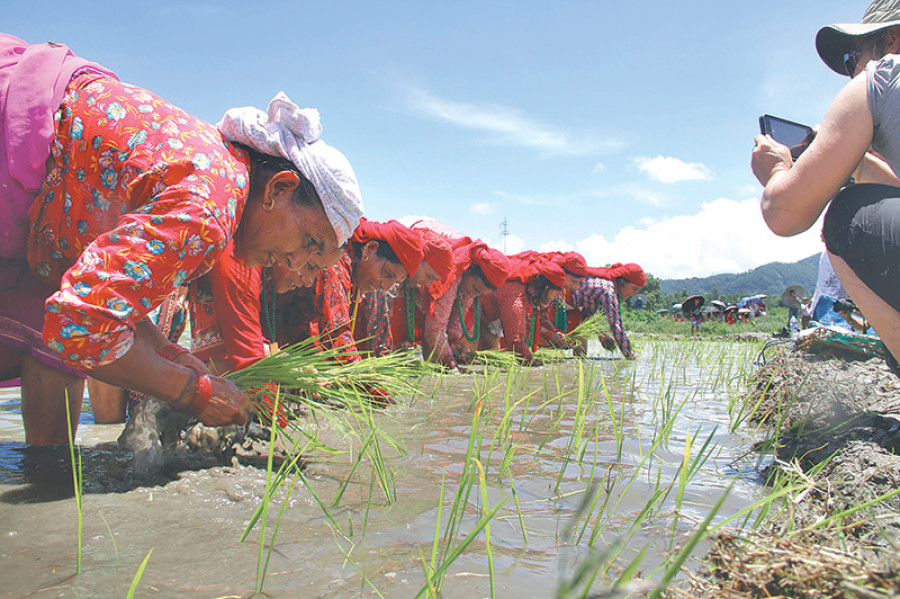Money
Another bumper harvest predicted
Weathermen have forecast a normal monsoon, bringing hope for another good year for paddy production after recording an all-time high harvest this fiscal year.
Sangam Prasain
Weathermen have forecast a normal monsoon, bringing hope for another good year for paddy production after recording an all-time high harvest this fiscal year.
With this hope, the 14th National Paddy Day was observed across the country on Thursday which marks the beginning of the summer paddy planting season.
As of Tuesday, paddy had been transplanted on 9 percent of the 1.5 million hectares of rice fields, and transplanting is progressing at a good speed, government officials said.
The paddy planting event organized at Jhokhel, Bhaktapur this year is not only a celebration, said Shankar Sapkota, deputy spokesperson for the Ministry of Agricultural Development. “It is a platform for policymakers, planners, farmers and experts who gathered there to engage in a healthy debate,” he said.
“Obviously, this year’s paddy harvest has encouraged farmers and policymakers and boosted the economy, and we want to continue the trend in the next fiscal year too.”
The government has targeted to increase paddy output to 5.4 million tonnes in the next fiscal year from this year’s record 5.23 million tonnes.
This target is attainable because a number of programmes and projects have been launched to boost paddy production, said Sapkota.
In 2016, the government launched the first paddy mission aimed at boosting output and productivity to feed the country’s swelling population.
The three-year mission has set a target to become self-reliant in rice and be in a position to export paddy by the end of the scheme. The mission covers 35 districts.
Likewise, another project was launched two years ago to produce fine and aroma varieties of paddy amid growing demand.
This fiscal year, the government has implemented the Rs130-billion Prime Minister Agriculture Modernisation Project, which envisages adopting modern farm techniques to boost productivity, and making the country self-reliant in food.
Jhapa has been named a super zone for paddy under the scheme. “All these projects are making big impacts,” said Sapkota. To ensure timely availability of chemical fertilisers, the government has procured the highest amount of the soil enrichers this fiscal year. According to the ministry, the government has bought a record 332,000 tonnes of fertilisers, of which 220,000 tonnes have been sold.
“Fertiliser prices have dropped significantly in the international market, enabling the government to buy more,” said Sapkota. “There will be no shortage of fertilisers this year.”
He added that the government had accorded priority to small irrigation systems under the 10-year farm modernization project.
“Obviously, the monsoon is the single biggest factor to boost productivity, and given a near normal forecast, we can make an early estimate that the paddy acreage will increase to 1.52 million hectares this season,” said Sapkota, adding that if the monsoon was good as projected, Nepal would see another bumper harvest.
The major constraint, however, is low productivity. Nepal is well behind major paddy producing countries in Asia in terms of productivity with a meagre 3.4 tonnes per hectare. India’s paddy productivity is 3.9 tonnes per hectare, Bangladesh (4.5 tonnes), China (9.5 tonnes), Thailand (6.5 tonnes) and Vietnam (7.5 tonnes).
“However, from an optimistic angle, we have opportunities to grow,” said Sapkota. “If our productivity increases to even 4 tonnes per hectare, we can graduate to a rice exporting country.” He said that the government had been studying various factors to boost productivity.
Thanks to a good monsoon, Nepal’s farm sector is expected to register a nine-year high growth rate of 5.32 percent this fiscal year ending mid-July after hitting rock bottom last fiscal year, the Economic Survey 2016-17 shows.
The survey said that bumper paddy harvests and a growth in the production of other key food grains helped the sector to make a recovery. Nepal’s farm sector saw a negative growth of 0.19 percent for the first time last fiscal year due to summer and winter droughts.
The average rainfall from June 10 to August 15 in the last fiscal year was 74.2 percent of the average rainfall recorded in the past 30 years.
The farm sector is expected to make a contribution of Rs691.2 billion to the country’s gross domestic product (GDP). This is 28.89 percent of the GDP, down from 31.1 percent recorded in the last fiscal.




 23.12°C Kathmandu
23.12°C Kathmandu














